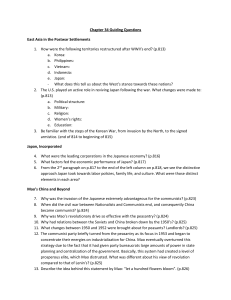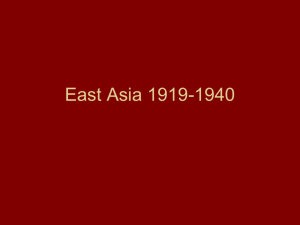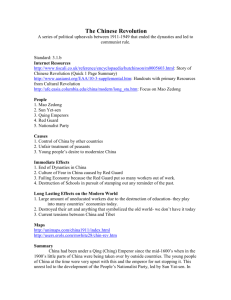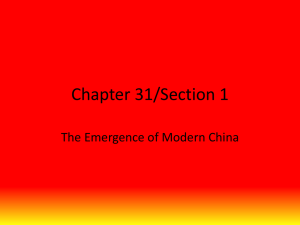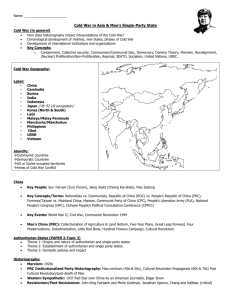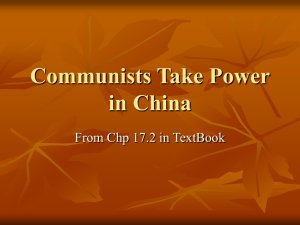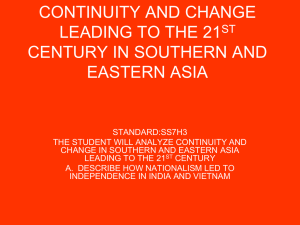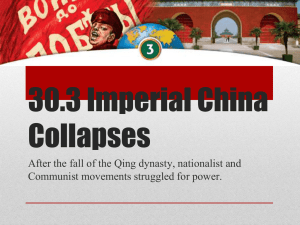ch41 - SoYoung Kim
advertisement
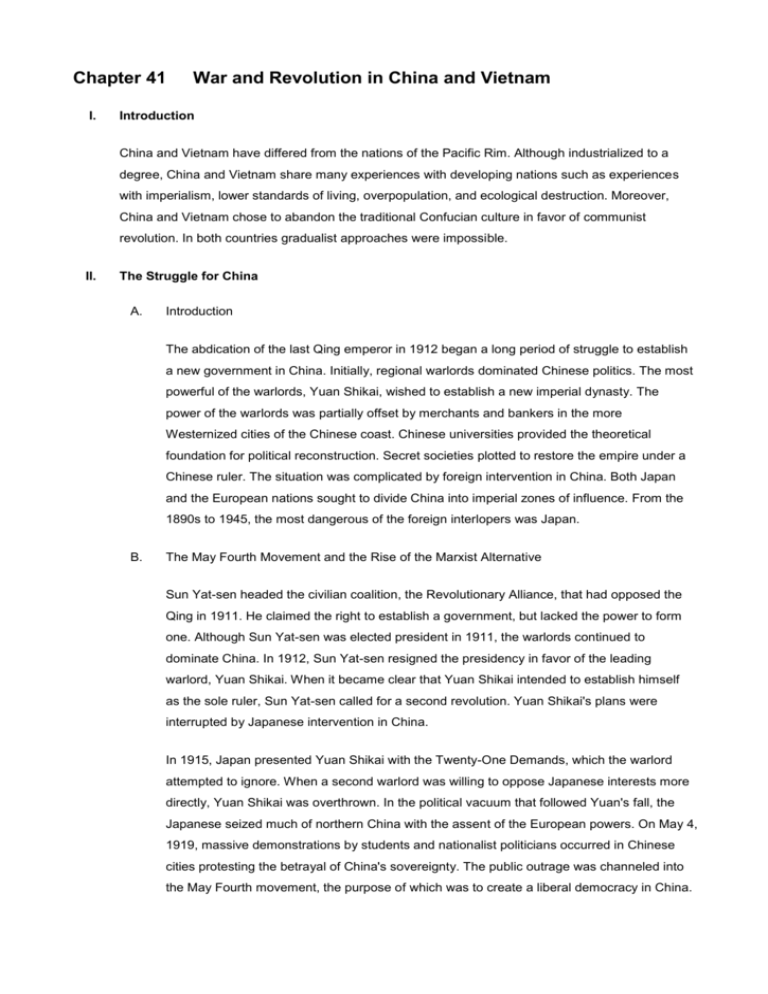
Chapter 41 I. War and Revolution in China and Vietnam Introduction China and Vietnam have differed from the nations of the Pacific Rim. Although industrialized to a degree, China and Vietnam share many experiences with developing nations such as experiences with imperialism, lower standards of living, overpopulation, and ecological destruction. Moreover, China and Vietnam chose to abandon the traditional Confucian culture in favor of communist revolution. In both countries gradualist approaches were impossible. II. The Struggle for China A. Introduction The abdication of the last Qing emperor in 1912 began a long period of struggle to establish a new government in China. Initially, regional warlords dominated Chinese politics. The most powerful of the warlords, Yuan Shikai, wished to establish a new imperial dynasty. The power of the warlords was partially offset by merchants and bankers in the more Westernized cities of the Chinese coast. Chinese universities provided the theoretical foundation for political reconstruction. Secret societies plotted to restore the empire under a Chinese ruler. The situation was complicated by foreign intervention in China. Both Japan and the European nations sought to divide China into imperial zones of influence. From the 1890s to 1945, the most dangerous of the foreign interlopers was Japan. B. The May Fourth Movement and the Rise of the Marxist Alternative Sun Yat-sen headed the civilian coalition, the Revolutionary Alliance, that had opposed the Qing in 1911. He claimed the right to establish a government, but lacked the power to form one. Although Sun Yat-sen was elected president in 1911, the warlords continued to dominate China. In 1912, Sun Yat-sen resigned the presidency in favor of the leading warlord, Yuan Shikai. When it became clear that Yuan Shikai intended to establish himself as the sole ruler, Sun Yat-sen called for a second revolution. Yuan Shikai's plans were interrupted by Japanese intervention in China. In 1915, Japan presented Yuan Shikai with the Twenty-One Demands, which the warlord attempted to ignore. When a second warlord was willing to oppose Japanese interests more directly, Yuan Shikai was overthrown. In the political vacuum that followed Yuan's fall, the Japanese seized much of northern China with the assent of the European powers. On May 4, 1919, massive demonstrations by students and nationalist politicians occurred in Chinese cities protesting the betrayal of China's sovereignty. The public outrage was channeled into the May Fourth movement, the purpose of which was to create a liberal democracy in China. The May Fourth movement called for the abandonment of Confucianism in favor of Western ideals. Until the warlords could be neutralized, the rhetoric of the May Fourth movement could not be realized. Awareness of the futility of a democratic philosophy bereft of force led to the emergence of communism within China. The Russian Revolution seemed to serve as a model for possible reform in China. Under Li Dazhao, Marxist discussion groups were founded in the universities and the coastal cities. With support from Sun Yat-sen, Marxists founded the Socialist Youth Corps in 1920 to recruit among urban workers. In 1921, leaders of the Marxist movement met in Shanghai and formed the Communist party of China. C. The Seizure of Power by the Guomindang, or Nationalist Party In 1919, Sun Yat-sen attempted to revitalize the reform movement by creating the Nationalist Party of China (Guomindang). The Nationalists began to militarize in order to drive out the warlords. Sun Yat-sen enunciated a broad program of reform. The foundation of Nationalist power was among commercial groups in the coastal cities as well as some warlords and criminal groups, such as the Green Gang of Shanghai. Sun Yat-sen also formed an alliance with the Communist party in 1924. Unable to attract support from the West, the Nationalist party did receive advisors and material assistance from the newly formed Soviet Union. As the Nationalists began to militarize, Chiang Kai-shek became a close associate of Sun Yat-sen. While the Nationalists were engaged in political and military organization, the chaotic economic situation in the countryside deteriorated. The failure to address the problems of the peasants was a severe drawback for the Nationalists. D. Mao and the Peasant Option Mao Zedong came from a peasant background, but soon joined the revolutionary and nationalist movement in China. He was heavily influenced by the Marxist thinkers in Beijing and began to see the peasants as the key to a successful revolution. Because the concept of a peasant revolution did not fit the classic Marxist revolutionary scheme, Mao remained in the background of Communist leadership in the 1920s. His rise to leadership in the Communist party of China occurred after a split between the Nationalists and Communists. After Sun Yat-sen's death in 1925, Chiang Kai-shek began to expand the territory controlled by the Nationalists. He seized Shanghai in 1927. By the late 1920s, he had captured Beijing and controlled enough of China to be regarded as the most powerful leader. In a sense, Chiang Kai-shek was simply the most influential warlord. Chiang ruthlessly eliminated his political rivals. Among those purged were all of the Communists in the central committee. In 1927, Chiang's army and criminal supporters liquidated all Communists in the city of Shanghai. When the purges spread to other cities, civil war broke out between the Nationalists and the Communists in China. E. Reaction Versus Revolution and the Communist Victory The Nationalists enjoyed the support of Chinese commercial interests, many intellectuals, rural landlords, and the military. Chiang also renewed appeals to the West for support against the Communists. Ironically, the Nationalists continued to receive support from the Soviet Union. When Chiang smashed the urban workers groups, Mao's plan to base the revolution on the peasantry gained greater credibility. There were few alternatives. In the late 1920s, Mao centered the Communist movement in Hunan province, where he established soviets. By 1934, repeated Nationalist campaigns successfully drove the Communists from Hunan. Mao led his supporters on the Long March to Shaanxi province in northwestern China, where the Communists remained until the mid-1940s. Mao's ability to survive made him the recognized leader of the Communist party. When it appeared that Chiang's Nationalists might also root the Communists out of Shaanxi, the Japanese invaded China in 1937. Even as the Japanese advanced, Chiang continued to press his campaign against the Communists. Only when forced by military associates, Chiang formed an alliance with the Communists to form a united front against Japanese aggression. While the Japanese successfully defeated Chiang's conventional forces along the Chinese coast, the Communists waged a more successful guerrilla campaign and gained control of much of northern China. When the war ended, the Nationalists were restricted to the northern Chinese cities. By 1945, when World War II ended, the Communists held a clear advantage. Mao was able to drive the demoralized remnants of the Nationalists to the island of Taiwan in 1949. Mao proclaimed the People's Republic of China. Critical to Communist success was their program of rural reform. Mao concentrated on social and economic reform for the peasantry, a commitment that won many to his party. III. Mao's China and Beyond A. Introduction The Chinese Communists had the advantage of establishing control over a unified nation from which foreign invaders had been expelled. The party enjoyed strong political and military organization. The People's Liberation Army continued to administer much of the country after 1949, although the military accepted the party's leadership. Following their victory over the Nationalists, the Communists moved to restore China's dominance in East Asia. As Communist China's power grew, a split developed with the Soviet Union. China demonstrated its international strength in defeating India in a brief border war and exploding a nuclear device. B. Planning for Economic Growth and Social Justice Between 1950 and 1952, the landlord class in China was eliminated. The government redistributed land to peasants and formed village cadres. As in Russia, the goal of the Communists was industrialization. Five-year plans were begun in 1953. To achieve development, the party became urban- based, undertook central economic planning, and turned away from the peasants. Mao found this direction unacceptable and forced the party to change directions in the mid-1950s. Mao disliked bureaucratic elites and intellectuals. He continued to identify the revolution with the peasants. In 1955, Mao introduced the Mass Line approach leading to farming collectives that brought peasants together in production groups. Following outspoken criticism of the Communist regime in 1957, Mao roughly repressed dissidents. With political opposition subdued, Mao introduced the Great Leap Forward in 1958. Industrialization was to be based in rural communes rather than urban factories. The immediate consequences of collectivization and the Great Leap Forward were disastrous for development in China. Famine and falling production caused hardship. Economic regression was further complicated by massive population growth. Initially resistant to the idea of birth control, the Communist government limited families to one child in the 1980s. By 1960, Mao's failures cost him his position of leadership of the nation. Pragmatists, headed by Zhou Enlai, decided to restore central planning and private landholding. C. "Women Hold Up Half of the Heavens" Mao's revolutionary social program included improvements in the social and economic status of women. The failure of the Nationalists to support women's rights led many women to embrace the Communists. The Communist party, in contrast, used women as teachers, laborers, and even soldiers. Some women rose to positions of influence within the party. The Communist victory brought full legal equality to Chinese women and entry into the work force. As was often the case in other nations, women were still expected to fulfill traditional roles as wives and mothers within their households. Males continued to dominate the upper reaches of the party structure. Mao's wife temporarily enjoyed exceptional political influence, but her position depended on her relationship to her husband. D. Mao's Last Campaign and the Fall of the Gang of Four Mao continued to oppose the pragmatists and to develop a base of mass support. In 1965, he launched the Cultural Revolution. Student demonstrations began mass criticisms of Mao's political enemies. They soon drew the support of the lower echelons of the army. Bureaucrats and managers were deprived of their positions and sent to the country to work off their "crimes." As chaos spread, the army leaders forced the lower echelons back into line. The pragmatists launched political counter strokes to regain control of the government. The Gang of Four, including Mao's wife, Jiang Qing, attempted to sustain the Cultural Revolution until Mao's death in 1976. The military and the pragmatists, acting together, arrested the Gang of Four, who were purged from the Communist party. Following their victory, the pragmatists opened China to greater Western influence and considerable capitalization. Of all the revolutionary regimes, the Chinese have been most successful at redistributing wealth and supplying social services to the peasantry. The Chinese have raised standards of living, although relative poverty is still common. China's industrial and agrarian sectors have been more productive than democratic India. IV. Colonialism and Revolution in Vietnam A. Introduction Vietnam's experience with Western colonialism had much in common with China. Like the Chinese, exposure to imperialism caused the Vietnamese to abandon Confucian elements of their culture. Catholic missionaries first stimulated French interest in Vietnam. When the Tayson Rebellion in southern Vietnam toppled the Nguyen dynasty in the 1770s and the northern dynasty was similarly disabled, the French Bishop of Adran chose to support the surviving member of the Nguyen house, Nguyen Anh. By 1802, Nguyen Anh's armies, supported by the French, successfully defeated the Tayson in both the south and north. He was proclaimed the Gia Long emperor of a united Vietnam. The French achieved great influence in the new court. Gia Long and his successor, Minh Mang, emphasized the Confucian tradition of government in Vietnam. Under Minh Mang, the Vietnamese government began to persecute Catholics. The French chose to intervene militarily to protect Vietnamese Catholics. They exploited divisions in Vietnam in order to justify piecemeal conquest of Vietnam, Cambodia, and Laos. By the 1890s, the French had reduced the Nguyen to the status of puppet rulers. French exploitation devastated the peasantry of northern Vietnam. Many peasants chose to migrate to the Mekong delta region in the south and became virtual serfs on the French plantations. B. Vietnamese Nationalism: Bourgeois Dead Ends and Communist Survival Despite sporadic guerrilla attempts to support the Nguyen, the failure of the dynasty to free itself of French influence discredited the Confucian regime. In the early years of the twentieth century, French colonialism produced a Western- educated middle class in Vietnam. Within this group, a nationalist party first emerged. By the 1920s, attempts at peaceful protests had failed, leaving only a revolutionary option. Those who proposed the violent overthrow of the French administration were organized in the Vietnamese Nationalist party. A series of failed revolutions and French repression virtually destroyed the party. In the wake of the failed middle-class movement, the Communist party of Vietnam inherited the revolutionary mantle. In the late 1920s, the leader of the Communists was Nguyen Ai Quoc, later known as Ho Chi Minh. The party shifted from dependence on urban workers to a peasant-led revolution in the 1930s. Again, failed attempts at revolution smashed much of the party, leaving only an underground organization. When the French were weakened by the advance of the Japanese in 1941, the Communists were prepared to reemerge as a revolutionary force. C. The War of Liberation Against the French The Communist nationalist movement, the Viet Minh, operated primarily in northern Vietnam. As the Japanese were defeated, the Viet Minh were well placed to step into the political vacuum. They immediately carried out social and economic reforms within the regions they controlled. Under General Vo Nguyen Giap, Viet Minh forces conducted a successful guerrilla campaign against Japanese-held portions of Vietnam. By 1945, the Viet Minh controlled the northern capital of Hanoi and proclaimed an independent Vietnam. After the war, the French attempted to restore their hold over southern Vietnam. General Giap swiftly renewed the guerrilla war, this time against the French. After the Vietnamese won the critical battle of Dien Bien Phu in 1954, an international conference at Geneva conceded the Viet Minh control of the northern portions of the country. The conference declared that an election would determine the political fate of the south. D. The War of Liberation Against the United States No elections were ever held. The United States, who had supported the French, now determined to halt the advance of communism in Asia. The U.S. selected Ngo Dinh Diem, a nationalist leader, to create a new government in southern Vietnam. A Catholic and long allied with the United States, Diem enjoyed little support in Vietnam. Diem attempted to crush Communist cadres in southern Vietnam, while the northern Vietnamese government attempted to ship men and arms to the south. As the war expanded, both the United States and northern Vietnam expanded their support. When it appeared that Diem might fail, the U.S. approved a military coup in the south. The U.S. continued to escalate support in men and material for the southern government, but were unable to crush the Communists. As the government in the south began to fall apart, the U.S. withdrew from the war in 1975. The Communists reunited Vietnam for the first time in more than a century. E. After Victory: The Struggle to Rebuild Vietnam Diplomatic isolation imposed by the United States and border clashes with China made it difficult for the Communist government to make much headway in the post-war program of development. The heads of the party in Vietnam expended much effort in eliminating enemies and attempted to maintain a strongly centralized economic system. The result was a lack of progress. In the 1980s, the government began to liberalize the economy and to permit investment from the West and industrialized nations of Asia. Vietnamese relations with the United States have recently improved. V. Conclusion: Revolutions and Civilization in China and Vietnam Both China and Vietnam have undergone revolutionary transformations in the twentieth century. New governments eliminated much of the traditional elite. The Confucian system of education was supplanted by public education programs. Women's status has improved. Marxism replaced Confucianism as the guiding orthodoxy. Some aspects of traditional culture have been retained. Both societies continue to harbor suspicions about commercial classes. Political philosophy continues to stress the duty of the government to rule for the benefit of the people. Both nations continue to stress harmony and secularism. The traditional assumption of cultural superiority remains. Despite Mao's resistance, the existence of a bureaucratic elite is evident. In these ways, the traditional culture of East Asia has survived a period of revolution.
